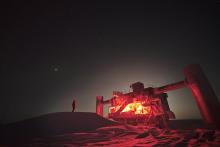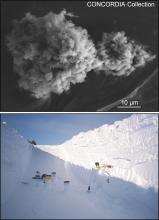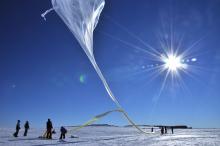Listen to today's episode of StarDate on the web the same day it airs in high-quality streaming audio without any extra ads or announcements. Choose a $8 one-month pass, or listen every day for a year for just $30.
You are here
Better Hunting
The pure white ice of Antarctica is the best place on Earth to hunt for meteorites. Scientists have picked up about 50,000 of them there — almost two-thirds of all the meteorites ever found. And hundreds of thousands more may await discovery.
The process isn’t easy, though. An expedition takes months of planning and weeks of criss-crossing the ice on snowmobiles. But the hunters might have found a helper — the equivalent of a meteorite-sniffing hound dog: an artificial-intelligence technique known as machine learning.
Meteorites are bits of debris from asteroids and comets. Studying them helps scientists piece together the history of the solar system. And some of the meteorites come from the Moon and even Mars.
Meteorites are hard to find, though. Most of them look a lot like Earth rocks, so they blend in to the background. In Antarctica, they stand out.
Scientists fed information on where meteorites have been found in Antarctica into their computers. They also entered details on the ice, the weather, the contours of the rock below the ice, and other conditions. From that, the machines learned how to predict where meteorites are likely to be found.
The computers came up with 600 plots, each covering one and a half square miles. Comparing the map with known success rates in the plots that have already been scoured showed an accuracy of 80 percent. So the maps may yield better hunting for future expeditions.
Script by Damond Benningfield






